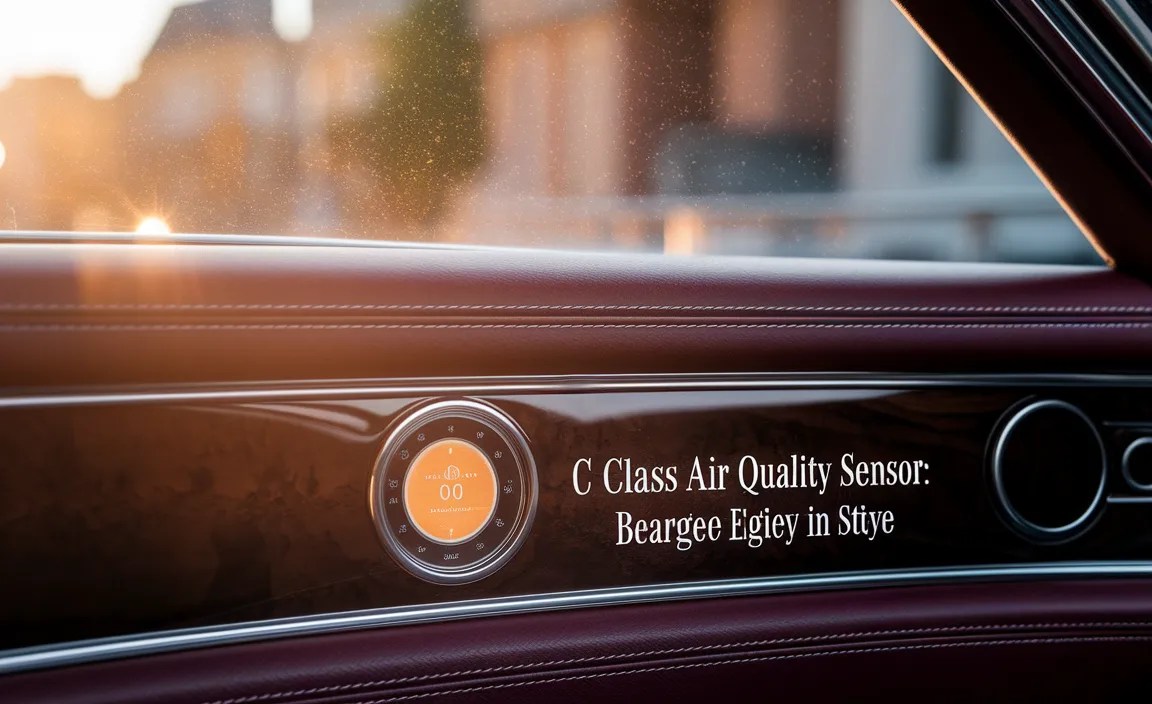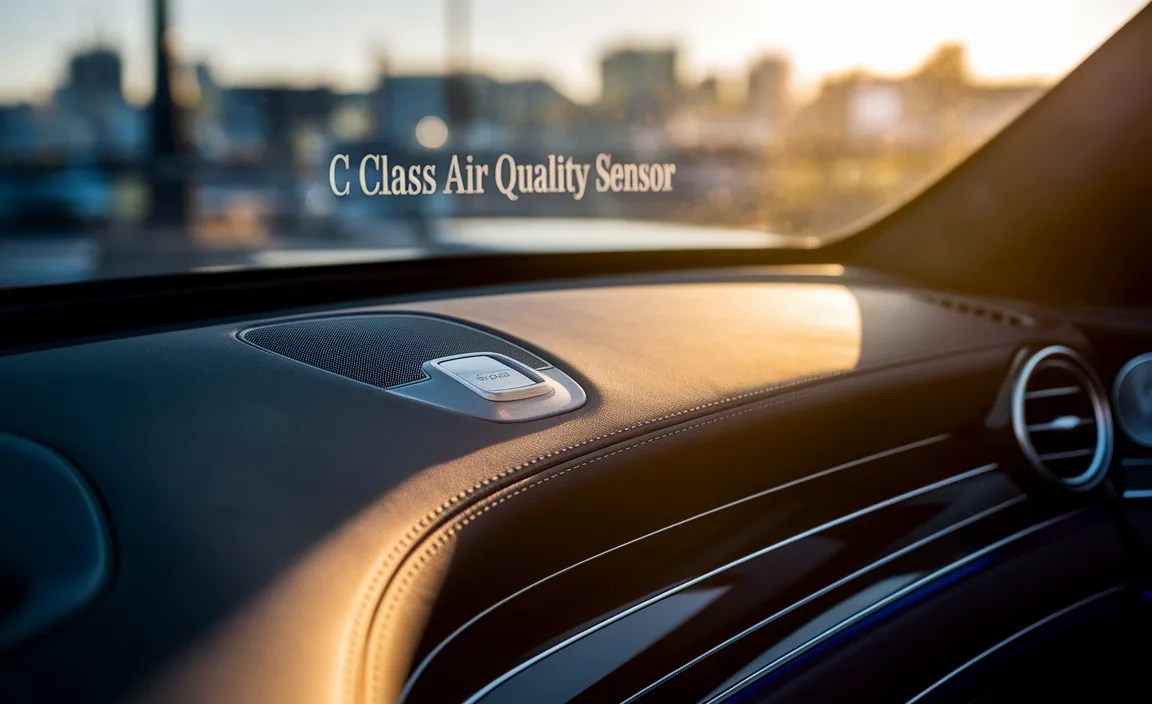C Class Air Quality Sensor: The Ultimate Performance
The C Class air quality sensor is crucial for maintaining clean cabin air, optimizing HVAC performance, and enhancing your driving comfort. This guide provides a clear understanding of its function and importance for your Mercedes-Benz C-Class.
Are you noticing a persistent musty smell in your Mercedes-Benz C-Class, or is your climate control struggling to maintain a consistent temperature despite being set correctly? These issues, while seemingly minor, can often be traced back to a component that works silently behind the scenes: the air quality sensor.
This small but mighty device plays a significant role in your car’s overall comfort and the health of its occupants. Many owners might overlook its existence, but understanding its function is key to unlocking the ultimate performance of your C-Class’s climate system. We’ll break down exactly what the C Class air quality sensor does, why it’s so important, and how it contributes to a superior driving experience.

What is a C Class Air Quality Sensor?
At its core, the C Class air quality sensor is an intelligent component designed to monitor the air quality both inside and outside your vehicle’s cabin. Think of it as a vigilant guardian for your environment, constantly sampling the air for a variety of pollutants and undesirable substances.
This sensor is typically integrated into your Mercedes-Benz C-Class’s climate control system (also known as the THERMATIC or THERMOTRONIC system). Its primary function is to detect the presence of specific airborne contaminants. These can include:
- Particulate matter (like dust and soot)
- Nitrogen oxides (NOx)
- Carbon monoxide (CO)
- Volatile Organic Compounds (VOCs)
- Ozone (O3)
When the sensor detects a significant level of these pollutants, it sends a signal to the car’s climate control module. This module then automatically adjusts the system to prioritize cleaner air for the cabin occupants. For instance, it might close the air recirculation flaps to prevent outside air from entering or automatically switch to a higher-efficiency filtration mode if your car is equipped with advanced cabin filters.
The Importance of Optimal Air Quality in Your C-Class

Maintaining pristine air quality within your Mercedes-Benz C-Class isn’t just about luxury; it’s a critical aspect of driver and passenger well-being, as well as the efficient operation of your vehicle. The air quality sensor directly contributes to several key areas:
Health and Well-being
The air we breathe inside our cars can be just as important as the air outside, especially for those who spend a significant amount of time driving or are sensitive to airborne irritants. Pollutants like dust, pollen, exhaust fumes, and VOCs can exacerbate allergies, trigger asthma symptoms, and generally degrade the comfort of the cabin environment. The C Class air quality sensor acts as an automatic defense, helping to minimize your exposure to these harmful substances.
Enhanced Driving Comfort
A compromised cabin air environment can lead to discomfort, fatigue, and distraction. Smells from external sources, such as diesel fumes or agricultural odors, can be highly unpleasant and persistent. The air quality sensor ensures that the climate control system reacts proactively to these external incursions, maintaining a pleasant and neutral scent within the cabin, allowing you to focus on the driving experience.
Climate Control System Efficiency
When the air quality sensor detects poor outdoor air, it can instruct the climate control system to work more efficiently. By closing off external air intakes and recirculating cleaner cabin air, or by directing air through the most effective filters, the system can maintain the desired cabin temperature more effectively. This prevents the HVAC system from overworking to combat external pollutants, potentially improving fuel efficiency slightly and prolonging the life of climate control components.
Protecting Interior Surfaces
While not its primary function, reduced exposure to airborne particulates and pollutants can also contribute to keeping your car’s interior surfaces cleaner for longer. Less dust and grime settling on dashboards, upholstery, and screens means less frequent deep cleaning.
How the C Class Air Quality Sensor Works

The magic of the C Class air quality sensor lies in its ability to detect specific chemical signatures and particulate matter in the air. While the exact sensing technology can vary slightly between model years and specific C-Class generations, they generally operate on principles that identify undesirable airborne components.
Here’s a simplified breakdown of its operational process:
- Air Sampling: The sensor is strategically placed within the vehicle’s HVAC intake system, where it continuously samples the air entering the cabin from the outside. Some systems may also sample interior air, providing a comprehensive view.
- Detection and Measurement: Using advanced sensing elements, the air quality sensor analyzes the sampled air for specific compounds and particles. Different types of sensors exist, such as electrochemical sensors for gases (like NOx or CO) and optical particle counters for fine dust and soot.
- Signal Transmission: Once a certain threshold of detected pollutants is reached, the sensor generates an electrical signal. This signal is sent to the central engine control unit (ECU) or the dedicated climate control module (N70 or equivalent).
- System Response: The climate control module interprets the signal from the air quality sensor. Based on pre-programmed logic and the severity of the detected pollution, it initiates an automatic response. This typically involves:
- Activating the air recirculation mode.
- Closing the fresh air intake flaps.
- Potentially switching to a special “auto” mode that prioritizes immediate air purification using the car’s cabin air filter.
- In some advanced systems, it might also engage ionizers or other air purification technologies if equipped.
- Continuous Monitoring: The sensor continues to monitor air quality, and once the external pollution levels drop, the climate control module will typically revert to drawing in fresh outside air automatically, ensuring a balance of fresh air and optimal quality.
Types of Sensors and Technologies
Mercedes-Benz employs sophisticated sensor technology to achieve this level of responsiveness. While specific details can be proprietary, common sensing mechanisms include:
- Electrochemical Sensors: These sensors use chemical reactions to detect specific gases like nitrogen oxides (NOx) and carbon monoxide (CO). The reaction produces an electrical current proportional to the gas concentration.
- Optical Particle Sensors: These use light scattering or absorption to detect and quantify the concentration of fine particles (PM2.5, PM10) in the air.
- Metal Oxide Semiconductor (MOS) Sensors: These can detect a broad range of VOCs and other gaseous pollutants by measuring changes in electrical resistance of a semiconductor material when exposed to certain gases.
These individual sensing elements are often combined into a single module for efficiency and space-saving within the vehicle’s complex HVAC architecture.
Location of the C Class Air Quality Sensor

Pinpointing the exact location of the air quality sensor can vary by model year and specific C-Class generation (e.g., W205, W206). However, it is almost always located in a position where it can effectively sample incoming air before it reaches the cabin.
Common locations include:
- Near the HVAC Air Intake: This is the most frequent placement. The HVAC system’s fresh air intake is usually found under the hood, often near the base of the windshield, behind the plastic cowling. The sensor, or a small grille connected to it, would be positioned here to draw in ambient air.
- Behind the Glove Box: In some configurations, the sensor might be integrated into the HVAC unit itself, which is accessible behind the glove box. This allows it to monitor air after it has passed initial filters but before it’s distributed into the cabin.
- Integrated within the HVAC Housing: The sensor module can be a component of the larger air conditioning and heating unit, embedded within its housing.
Note for DIY Enthusiasts: Accessing and replacing the air quality sensor can range from relatively simple to quite complex, depending on its location. Always consult your Mercedes-Benz C-Class’s specific service manual or reliable online resources for detailed instructions and diagrams relevant to your model year. Improper disassembly can lead to damage to other components.
Identifying the Sensor
Visually identifying the sensor can be challenging as it’s often a small, unobtrusive component within the HVAC system. It typically has a plastic housing and may feature a small grating or opening through which air can enter for measurement. If you are attempting to locate it, look for a small electrical connector attached to a plastic module near the main HVAC intake or within the HVAC housing.
Troubleshooting Common Issues with Your Air Quality Sensor
While designed for longevity, like any electronic component, the C Class air quality sensor can sometimes malfunction or require attention. Recognizing the signs of a problem and knowing how to approach troubleshooting is crucial for maintaining a comfortable cabin environment.
Signs of a Malfunctioning Air Quality Sensor
- Persistent Odors: If you notice unpleasant smells entering the cabin, especially when the system should be actively filtering them out, the sensor might not be signaling the climate control to recirculate.
- Climate Control Not Activating Recirculation Automatically: If you drive through areas known for poor air quality (e.g., heavy traffic, industrial zones) and your car continues to draw in outside air, the sensor may have failed to detect the pollution and trigger the recirculation mode.
- “Check Air Quality Sensor” Warning: Modern Mercedes-Benz vehicles often have sophisticated diagnostic systems. You might see a warning message on your infotainment screen or instrument cluster specifically indicating an issue with the air quality sensor.
- Reduced HVAC Performance: In some cases, a faulty sensor might send incorrect data, causing the climate control system to operate inefficiently, leading to poor temperature regulation or airflow issues.
DIY Troubleshooting Steps
Before concluding that the sensor is faulty, consider these simpler checks:
- Check Cabin Air Filter: A severely clogged or dirty cabin air filter can restrict airflow and sometimes mimic symptoms of other HVAC issues. Replacing the cabin air filter is routine maintenance and a good first step. You can find instructions and replacement filters from reputable automotive parts suppliers.
- Clean Sensor Area (if accessible): If the sensor’s intake grille is accessible without major disassembly, a gentle cleaning with compressed air can remove dust or debris that might be obstructing it. Caution: Avoid using liquids or harsh tools.
- Test Recirculation Manually: Manually activate the recirculation mode via your climate control panel. If this effectively blocks outside air and improves the situation, it suggests the automatic function tied to the sensor is the problem.
When to Seek Professional Help
If the above steps do not resolve the issue or if you are uncomfortable with disassembling parts of your vehicle, it’s best to consult a Mercedes-Benz specialist or dealership. They have the diagnostic tools (like the XENTRY/DAS system) and expertise to:
- Read specific diagnostic trouble codes (DTCs) related to the HVAC system and air quality sensor.
- Accurately pinpoint the sensor’s location and condition.
- Perform precise replacements or recalibrations if necessary.
Replacing the C Class Air Quality Sensor
Replacing a faulty C Class air quality sensor is a repair that can often be handled by experienced DIYers, but it’s important to have the right information and tools. The complexity will heavily depend on the sensor’s specific location for your C-Class model.
Tools and Materials You Might Need
- New C Class Air Quality Sensor (ensure it’s compatible with your specific model year and VIN)
- Set of Torx and Phillips head screwdrivers
- Plastic trim removal tools (to avoid scratching)
- Socket set and ratchet
- Possibly a small mirror and flashlight for inspection
- Service manual for your specific C-Class model
General Replacement Procedure (Illustrative)
Disclaimer: This is a general outline. Always refer to your vehicle’s specific service manual for detailed, model-accurate instructions.
- Safety First: Ensure the vehicle is turned off and the battery is disconnected or that you know how to safely work around live electrical components if necessary (though most sensor replacements can be done with the battery disconnected).
- Access the Sensor: This is the most variable step.
- If located at the HVAC intake (under the hood): You may need to remove plastic cowling pieces around the windshield wipers.
- If located behind the glove box: The glove box assembly might need to be removed. This often involves releasing clips or removing screws.
- If integrated into the HVAC unit: It might require removing ducting or other components of the HVAC system.
Use your trim removal tools carefully to detach panels, releasing retaining clips without forcing them.
- Locate and Disconnect: Once the sensor is visible, identify its electrical connector. Gently press the release tab on the connector and pull it away from the sensor.
- Remove the Old Sensor: The sensor is typically held in place by clips, screws, or a mounting bracket. Carefully remove any fasteners and then the sensor itself. Note the orientation of the old sensor for correct installation of the new one.
- Install the New Sensor: Place the new sensor into the mounting location, ensuring it is properly seated and oriented. Secure it with any screws or clips that were removed.
- Reconnect Electrical Connector: Plug the electrical connector firmly into the new sensor until it clicks or fully engages.
- Reassemble: Carefully reassemble all panels, trim pieces, and components that were removed, ensuring all clips and screws are properly secured.
- Reconnect Battery (if disconnected): Reconnect the battery terminals.
- Test the System: Start the vehicle and turn on the climate control. Check if the recirculation mode functions automatically as expected, especially when driving in different environments. You may need to drive the car for a short period for the system to recalibrate or for any warning lights to clear. If a warning light persists, diagnostic scanning may be required.
Aftermarket vs. OEM Sensors
When purchasing a replacement, you’ll often have a choice between Original Equipment Manufacturer (OEM) parts and aftermarket alternatives.
- OEM Sensors: These are made by or for Mercedes-Benz and are guaranteed to meet the brand’s exact specifications. They offer the highest assurance of fit, function, and longevity, but are typically more expensive.
- Aftermarket Sensors: These are produced by third-party manufacturers. Quality can vary significantly. While typically more affordable, it’s crucial to research brands known for reliability and ensure the part is listed as fully compatible with your C-Class model. Reading reviews from other Mercedes-Benz owners can be very helpful.
Optimizing Cabin Air Quality Beyond the Sensor
While the C Class air quality sensor is a crucial automated component, there are several other steps you can take to ensure the freshest, cleanest air possible in your Mercedes-Benz C-Class.
Regular Cabin Air Filter Replacement
This is arguably the most impactful maintenance item for cabin air quality. The cabin air filter traps dust, pollen, soot, and other airborne particles before they enter your cabin. Mercedes-Benz recommends replacing it at specific intervals (typically every 15,000-30,000 miles or annually), but it might need more frequent replacement in dusty or high-pollution environments. A clogged filter not only degrades air quality but also strains your HVAC system.
For detailed guidance on how to change your cabin air filter, you can often find step-by-step tutorials and specifications on the official Mercedes-Benz service portal or reputable automotive repair resources. For example, the U.S. Environmental Protection Agency (EPA) provides general information on vehicle emissions and air quality that underscores the importance of clean intake air: EPA Mobile Source Air Toxics.
Using Your Climate Control’s Manual Modes
Understand your climate control system’s features. Beyond the “Auto” mode, you have manual controls:
- Recirculation Mode: Use this manually when driving through tunnels, heavy traffic, or areas with strong smells. It stops outside air from entering.
- Fresh Air Mode: Use this to ventilate the cabin and replace stale air, especially after using recirculation for an extended period.
- Demist/Defrost Modes: These, while primarily for visibility, involve specific airflow patterns that can help clear the cabin of moisture and stale air.
Consider an Enhanced Cabin Filter
Some aftermarket cabin air filters offer enhanced filtration compared to standard paper filters. These may include:
- Activated Carbon Layers: These layers are highly effective at absorbing odors and certain gaseous pollutants.






